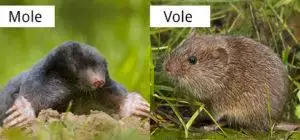Moles vs Voles
Call Now – (804) 457-2883
Moles vs Voles – The first step in solving a pest problem is identifying the critter involved – this can be the difference between a pest management program that works, and one that fails. To the untrained eye, damage from moles versus voles can look nearly identical. Both moles and voles spend most of their time underground, and both can seriously damage a yard or landscape. Understanding the following differences between moles and voles will be key to solving your pest problem.
Moles vs Voles: Burrows, Runways, and Mounds
Moles and voles traverse a landscape very differently, but both leave evidence of where they travel, which we call runways. While voles navigate above ground, moles only tunnel below the surface. You can identify a vole runway by the well-defined, roughly 2 inch wide, above-ground path. Vole runways are created as they scurry across the surface of the grass between burrows and their food sources. Moles, on the other hand, push dirt upwards as they dig tunnels beneath the surface, creating wide paths that make the surface of the landscape appear slightly elevated. While a vole burrow has clearly defined entrance and exit holes, a mole will create volcano shaped mounds of loose dirt, caused by the mole pushing dirt out of their tunnel.
Moles vs Voles: Physical and Behavioral Characteristics
Moles and voles differ from each other greatly when it comes to physical appearance. Voles have sharp incisor teeth, blunt noses, sturdy round bodies, short tails, thick fur, small eyes, and small ears — their physical features are relatively similar to those of most mice; this is not true for moles. Moles have tiny eyes, long noses, large shovel like feet with large claws, and thick fur. Moles are virtually blind, but are physically optimized for spending all of their time underground, digging runways while hunting worms and grubs in the dark. Voles spend comparatively more time above ground than moles, and their sharp incisor teeth are necessary for their diet of seeds, roots, and other vegetation.
Moles
- Damage landscapes and gardens
- Don’t enter buildings
- Won’t leave burrows unless absolutely necessary
- Moles are insectivores
- Consume food equivalent to 80% – 100% of their own body weight each day
Voles
- Damage plants, fruit trees, and landscapes
- Occasionally enter buildings
- Only leave burrows for 10 minutes at a time
- Voles are rodents
Getting Rid of Voles
- Practice exclusion at the ground level to keep voles out of buildings
- Remove any excessive landscaping and weeds that may be providing abundant food or cover
- Both traps and rodenticide will be required, due to their quick reproduction cycles
- Place traps and bait stations near shrubbery, along runways, and near burrow openings
Getting Rid of Moles
- Focus your attention around trees, landscaping, and flower beds
- Pay special attention to fence-lines and driveways, this is where you might find mole “super-highways”, which are frequently traveled by more than one mole
- Poke holes into mole runways, if the holes are plugged when you return the next day, it is an active mole runway
- Use traps and Talpirid mole bait as appropriate
Click here for additional information on mole removal
Click here for additional information on vole removal
Source: The Bell Report, Volume 40, Number 1, January – March 2021
